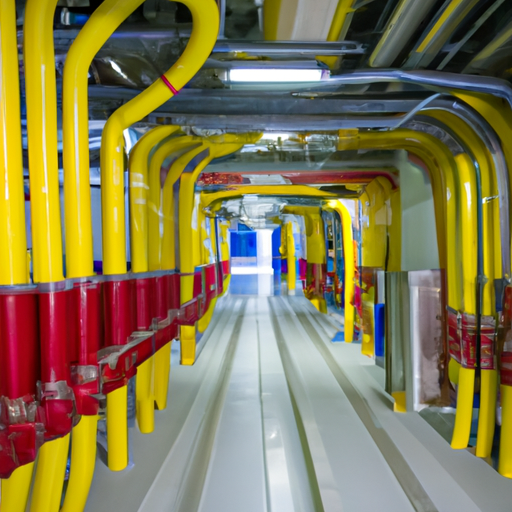أهمية أنظمة إخماد حرائق الأنفاق

تلعب أنظمة إخماد حرائق الأنفاق دورًا حاسمًا في ضمان سلامة الأشخاص والبنية التحتية في الأنفاق. تم تصميم هذه الأنظمة للكشف عن الحرائق وإطفائها بسرعة وكفاءة، مما يقلل من احتمالية حدوث خسائر في الأرواح وأضرار في الممتلكات. في هذه المقالة، سوف نستكشف أهمية أنظمة إخماد حرائق الأنفاق وكيفية عملها لحماية الأنفاق وشاغليها.أحد الأسباب الرئيسية لضرورة أنظمة إخماد حرائق الأنفاق هو التحديات الفريدة التي تمثلها الأنفاق في حالة حدوث حريق نار. الأنفاق عبارة عن مساحات مغلقة ذات تهوية محدودة، مما قد يؤدي إلى تراكم الدخان والغازات السامة بسرعة. وهذا يمكن أن يجعل من الصعب للغاية على الناس الهروب وعلى رجال الإطفاء الوصول إلى المنطقة المتضررة. بالإضافة إلى ذلك، يمكن أن تؤدي الطبيعة المحصورة للأنفاق إلى ارتفاع درجات الحرارة والحرارة الشديدة، مما يزيد من تفاقم شدة الحريق.لمواجهة هذه التحديات، تم تصميم أنظمة إخماد حرائق الأنفاق للكشف عن الحرائق في مراحلها المبكرة. يعد الاكتشاف المبكر أمرًا بالغ الأهمية لمنع انتشار الحريق وعدم السيطرة عليه. تستخدم هذه الأنظمة مجموعة من أجهزة كشف الحرارة والدخان الموضوعة بشكل استراتيجي في جميع أنحاء النفق. عند اكتشاف حريق، يقوم النظام بإطلاق إنذار، وتنبيه مشغلي الأنفاق وخدمات الطوارئ.
| خيمة الهرم | خيمة المظلة | خيمة ريدج | خيمة التنزه |
| خيمة القبة | خيمة تيبي | خيمة يورت | خيمة قابلة للنفخ |
| خيمة النفق | خيمة الكرة | خيمة الحديقة | خيمة الباب الخلفي |
 In addition to water-based systems, tunnel fire suppression systems may also incorporate other extinguishing agents, such as foam or gas. Foam-based systems work by smothering the fire, depriving it of oxygen and preventing its spread. Gas-based systems, on the other hand, displace oxygen from the fire’s environment, effectively suffocating it. The choice of extinguishing agent depends on various factors, including the type of fire and the specific requirements of the tunnel.Another critical aspect of tunnel fire suppression systems is their ability to control smoke and toxic gases. In the event of a fire, smoke can quickly fill the tunnel, hindering visibility and making evacuation challenging. To address this, tunnel fire suppression systems often incorporate smoke extraction systems. These systems use powerful fans to remove smoke from the tunnel, improving visibility and facilitating safe evacuation.Furthermore, tunnel fire suppression systems are designed to integrate with other safety measures, such as emergency lighting and evacuation systems. This integration ensures a coordinated response in the event of a fire, allowing for swift and efficient evacuation of tunnel occupants. Additionally, these systems can provide real-time information to emergency services, enabling them to make informed decisions and allocate resources effectively.
In addition to water-based systems, tunnel fire suppression systems may also incorporate other extinguishing agents, such as foam or gas. Foam-based systems work by smothering the fire, depriving it of oxygen and preventing its spread. Gas-based systems, on the other hand, displace oxygen from the fire’s environment, effectively suffocating it. The choice of extinguishing agent depends on various factors, including the type of fire and the specific requirements of the tunnel.Another critical aspect of tunnel fire suppression systems is their ability to control smoke and toxic gases. In the event of a fire, smoke can quickly fill the tunnel, hindering visibility and making evacuation challenging. To address this, tunnel fire suppression systems often incorporate smoke extraction systems. These systems use powerful fans to remove smoke from the tunnel, improving visibility and facilitating safe evacuation.Furthermore, tunnel fire suppression systems are designed to integrate with other safety measures, such as emergency lighting and evacuation systems. This integration ensures a coordinated response in the event of a fire, allowing for swift and efficient evacuation of tunnel occupants. Additionally, these systems can provide real-time information to emergency services, enabling them to make informed decisions and allocate resources effectively.



